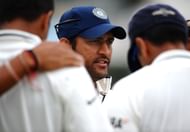As Alistair Cook called the declaration on England’s second innings, effectively ending the fourth Test in a draw, scenes of jubilation were displayed in the English dressing room, as it was an apt end to the series – in which India were completely outplayed after the first Test, and had no right to try deny England and lock the series at 2-2 in Nagpur.
The draw sealed England’s first Test series victory on Indian soil since 1984/85 and also signified India’s first home Test series loss since 2004/05. Now the Indian team, support staff, fans and BCCI must finally wake up and snap out of this state of denial they have been in for the last 18 months.
Prior to this series there was a lot of talk from the Indian camp – from players and administrators alike – about how spin friendly conditions would mean that India would comprehensively beat England (and Australia later on in the season); all of this stemming from India’s humiliating whitewashes on perceived green tops in England and Australia in their last two overseas outings. The move to have spin friendly decks throughout the series backfired from the moment the Indians decided they would bank on the conditions to win them Tests.
Somewhere along the line, India forgot they needed to pick a squad capable of winning, and to actually execute their plans throughout the series to win, whereas England turned up to India early, prepared well by playing a handful of warm up games (something that India fail to do each time they travel) and played well as a unit to take a series in India for the first time in 27 years.
The denial that this aging Indian squad is in decline started 18 months ago, with selectors sending the tried and tested batting line up to England rather than going for youth. With the old brigade failing, they were still sent to Australia, where they failed yet again. Had Dravid and Laxman not retired, they probably would have played against New Zealand and England alongside Sehwag and Tendulkar.
This short-sighted selection policy of not blooding youth in years gone by has finally caught up with India now that there are positions left vacant by former greats, and holes in the line up with dwindling stars. Furthermore, blaming conditions in England and Australia, and not giving enough credit to the opposition or looking at oneself about being able to conquer adverse conditions, has pushed India further in denial.
India had the perfect opportunity to blood youngsters against New Zealand in the build up to this series, to take the place of the Laxmans, Dravids, Tendulkars and Zaheers. It must be asked, why weren’t Abhinav Mukund, Ajinkya Rahane, Rohit Sharma, Ashoke Dinda and others given a go in that series against a weaker opposition. Are the selectors so short sighted, that these men are only seen as substitutes when one those who has permanently “cemented” his spot in the XI has been injured.
After falling behind 2-1 down after the third Test, the selectors needed to show they were doing something to address the issue of the team performing badly, and made scapegoats out of Harbhajan Singh and Yuvraj Singh, and completely avoided the elephants in the room – Sachin Tendulkar and Mahendra Singh Dhoni – and their woeful form in the last couple of years.
Dhoni must have known he was on thin ice during the last Test, because he actually showed great application with his batting and was very proactive in the field in the first innings, but it seems that Sachin Tendulkar must sit down with selectors and decide on his immediate future for the sake of Indian cricket.
Selectors need to also take a hardline on the two openers, who have both showed very lacklustre performances against quality opposition in the last few years. While Sehwag can still take the game away from the opposition every so often, Gambhir seems to have lost his Test game completely to the shorter formats. Many times in the series Gambhir looked as if he was batting for himself and not the team, none more evident than in Kolkata where he ran out both Sehwag and Pujara in each innings of the game.
There are many lessons to be learned from the last couple of years by the BCCI, which has yielded 10 Test losses, one draw and three wins (although two were against New Zealand), and it is time that the current system is overhauled. The BCCI should look into making the captain and coach more accountable, even offering them a chair at selection meetings so that they actually have some power off the field and can be fully accountable for what the team does on the field.
India must also now invest in and persist with youth that they believe show promise to be future leaders. There is no point making them short form specialists and relegate them to ODI and T20 cricket, as was done with Yuvraj Singh in his younger days. This horror run over the last year and a half might actually be a blessing in disguise and help India rebuild itself be as strong as ever. But that will happen only if India wants to learn from its errors and not be stuck in this state of denial, a state that we still seem mired in with Dhoni overnight stating that these Test losses don’t even come close to bowing out early in the 2007 World Cup, indicating perfectly where his priorities lie.
Follow IPL Auction 2025 Live Updates, News & Biddings at Sportskeeda. Get the fastest updates on Mega-Auction and cricket news


